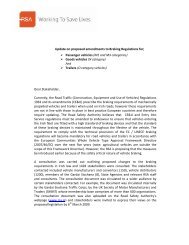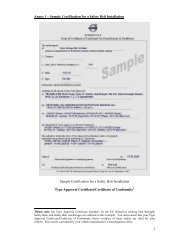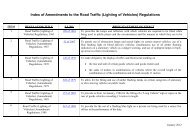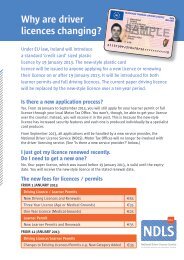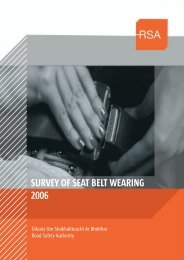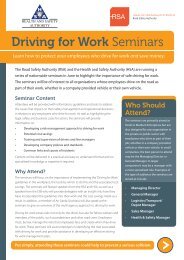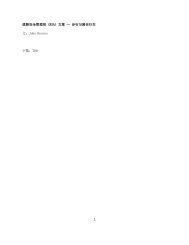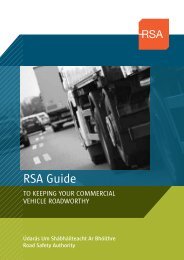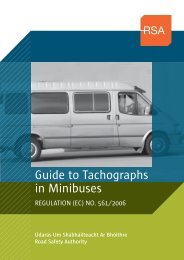(NCT) Manual 2010 - Road Safety Authority
(NCT) Manual 2010 - Road Safety Authority
(NCT) Manual 2010 - Road Safety Authority
You also want an ePaper? Increase the reach of your titles
YUMPU automatically turns print PDFs into web optimized ePapers that Google loves.
NATIONAL CAR TEST (<strong>NCT</strong>) MANUAL <strong>2010</strong><br />
EXHAUST SMOKE (DIESEL)<br />
2<br />
Method of Testing<br />
(A metered smoke test does not apply to vehicles registered before 1st January 1980)<br />
NOTES<br />
(Vehicles registered on or after 1st January 1980)<br />
1. All diesel engine tests must be performed according to EU Directives. Where an automatic transmission is<br />
fitted, the manufacturer’s guidelines should be consulted.<br />
2. No smoke test should be carried out without having done the pre test check detailed on page 11.<br />
3. It is absolutely essential that the engine is at normal operating temperature before carrying out a smoke<br />
test. Testers should ensure that engines are not warmed up by being left idling or at half throttle. They<br />
should be warmed up by normal driving.<br />
4. Engines left idling for any length of time will show a high smoke opacity reading.<br />
5. When carrying out this test the throttle must not be “blipped”.<br />
6. Exhaust emissions tests should not be performed on a vehicle where the oil level is well over the dipstick<br />
“Full” mark.<br />
7. Where the oil level is below the minimum level, the exhaust emission test should not be performed if it is<br />
necessary to purge the engine.<br />
8. Where a diesel engine is at the correct operating temperature and has been correctly purged and the first<br />
three readings are at or above 9.99, the exhaust emissions test may be aborted.<br />
9. Where a vehicle is producing black smoke to such an extent that the smoke meter might be damaged,<br />
the vehicle should be failed without carrying out the normal smoke test (see Test for vehicle registered<br />
prior to 1980.)<br />
10. Where a vehicle’s engine speed is limited when the vehicle is stationary, the smoke test may be carried<br />
out at the restricted rpm.<br />
Vehicles registered on or after 1st January 1980<br />
1. Check visually that the emission control system is complete and properly connected and that there are no leaks in the<br />
exhaust system.<br />
2. With the engine at normal operating temperature, raise the engine speed slowly to 2,500 rpm or half the engine manufacturer’s<br />
recommended governed speed whichever is less and hold for 20 seconds in order to purge the exhaust system. If the engine<br />
emits any unusual noises the test should be abandoned. Slowly raise the engine speed to its maximum rpm and note if the<br />
governor operates within the vehicle manufacturer’s recommended rpm setting. If not the test should be discontinued. Do not<br />
hold the engine at maximum rpm for any length of time.<br />
3. Connect the diesel smoke meter to the vehicle following the smoke meter manufacturer’s instructions. Depress the accelerator<br />
pedal firmly from the idling position to the maximum fuel delivery position following the prompts of the smoke meter. The<br />
smoke meter is programmed to ignore the first reading. The operation is repeated and if the reading on this occasion is less<br />
than 60% of the acceptable limit the test is ended. If the reading is not less than 60% of the acceptable limit, the operation is<br />
repeated. If the average of this and the previous reading is within the acceptable limit the test is ended. If the average readings<br />
are not within the limits the operation is repeated up to a maximum of three more times taking the average of the last two<br />
readings after which the test is ended.<br />
Vehicles registered before 1st January 1980<br />
4. For these vehicles, the exhaust emission should be assessed while driving the vehicle in the test area or test lane. Under no<br />
circumstances should the engine rpm be taken above that required to drive the vehicle through the various tests.<br />
11



